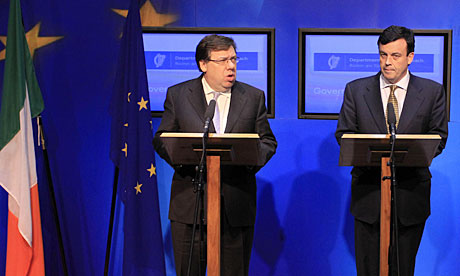WikiLeaks cables: IRA used Irish boom to turn 'respectable'
Leaked dispatches detail how group rode Celtic Tiger economy to move from racketeering to sophisticated business ventures

The IRA used the Celtic Tiger economic boom in the Irish Republic to diversify into "more sophisticated business enterprises" by buying up properties in London, Dublin and Spanish resorts, according to leaked US diplomatic cables released by WikiLeaks.
A senior Irish police officer told the American embassy in Dublin that the IRA used the booming Irish economy to move on from 1970s-style racketeering as it turned to "apparently respectable businessmen" to raise funds.The cables also show that the growth of the Celtic Tiger was so admired in Washington that the US treasury secretary travelled to Dublin in 2004 to discover the "secrets" of Ireland's success.
The IRA's changing business practices are revealed in a cable by Jonathan Benton, the then deputy chief of mission at the American embassy in Dublin, which reported on meetings with senior Irish police officers and senior officials from the department of justice.Benton wrote that a senior Garda, whose identity is being protected by the Guardian, "commented that IRA money was constantly moving, flowing from diversified sources into wide-ranging investments".
The cable added: "While the IRA had been proficient in smuggling, robbery, and racketeering since the 1970s, the Celtic Tiger economic boom of the 1990s had prompted the IRA to diversify into more sophisticated business enterprises.IRA investments now included real estate ventures in Dublin, London, and Spanish resort areas, handled by apparently respectable businessmen."
The cable said the new funds were being used to support Sinn Féin. "Irish officials, more generally, remain concerned that IRA funds acquired through sophisticated investments are seeping into resources available for Sinn Féin's political activities in the Republic of Ireland."
Sinn Féin described the claims as "complete nonsense". "Sinn Féin is the only party [in the Irish Republic] to publish its accounts before legislation was passed requiring others to do that," a spokesperson said.James Kenny, the US ambassador to Ireland at the time, also reported that Washington was so impressed by the growth of the Irish economy that the then US treasury secretary, John Snow, visited Ireland. A cable, sent on 24 November 2004, may make painful reading on both sides of the Atlantic after the Irish Republic agreed an €85bn bailout with the EU and the IMF last month.
"The … visit of US Treasury Secretary John W Snow was an opportunity for discussion on the 'secrets' of Ireland's success with policy-makers and businessmen who were the architects of Ireland's Celtic Tiger economy. These key figures noted that while the concepts behind Ireland's reforms had been simple, the political will to carry out the reforms had only come in the context of an economic meltdown in the mid-1980s. They said that good-faith relations with labour, investment in education, and a 'dictatorial' leadership that exposed industries to the full discipline of the market had been key to success."
The cable also:• Highlighted what it called "A Propitious Lack of Monetary Policy Tools". Critics of the euro have said that Ireland's inability to control its interest rates have compounded the country's problems. But the ambassador wrote: "An ironic feature of Ireland's success has been the Government's lack of monetary policy tools, remarked Cormack McCarthy, Chief Executive of the Ulster Bank. One might think that a country that had performed so well in terms of exports and investment would have relied heavily on interest rate and exchange rate levers, said McCarthy.
"As a euro-zone member, in fact, Ireland had ceded control of its monetary policy to the European Central Bank. The positive result, said McCarthy, were low interest rates … He believed that if Ireland had remained control of monetary policy, the Government would have been tempted to raise interest rates to slow rapid growth in the late 1990s. Instead, the low rates set by the ECB had been a boon to Ireland,s private sector and had lent a sense of stability and consistency to the Irish market for foreign investors."
• Padraig O'hUiginn, secretary of the department of the Taoiseach from 1982-1993, is quoted as saying that ideas to boost the Irish economy were obvious to a first year economics graduate student. The cable says: "O'hUiginn recalled drafting a proposal for economic recovery during that era, using ideas that were 'apparent to any first-year economics graduate student' - cut the fiscal deficit, spur competition, lower corporate taxes, etc. The ruling party at the time, Fine Gael, did not act on the proposal, but the Fianna Fail government elected in 1987 made the document the basis for the Program of National Recovery (PNR), which set forth the policies that underpinned Ireland's economic turnaround. Fianna Fail's 'great advantage' at the time, said O'hUiginn, was Ireland's economic crisis; with 18 percent unemployment and government debt at 130 percent of GDP, the political opposition, industry, and labor could not afford politically to impede solutions."
